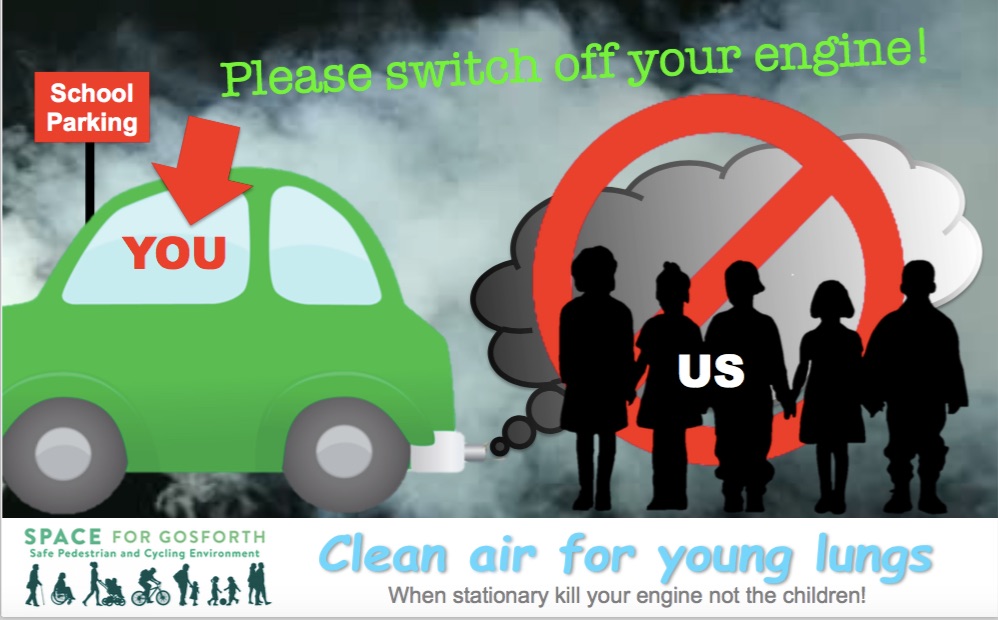
Newcastle City Council have released the Air Quality Feasibility Study that will be used for its forthcoming consultation. Whatever the final plan that is chosen, it must by law meet air quality limits within the shortest possible timescale. The question for the consultation therefore is how should that be achieved.
In addition to the main objective of meeting air quality limits in the shortest possible timescale, the Council has chosen three secondary objectives:
- to improve public health in our area in the shortest possible time;
- to enable future economic growth and sustain jobs and communities in the region; and
- to promote a fairer society and not detrimentally impact vulnerable populations.
Substantially the whole consultation is about how to improve public health. Air pollution is a major public health issue linked to multiple conditions including asthma, lung disease, heart disease, cancer, psychotic experiences such as hearing voices or intense paranoia, children’s cognitive development, dementia, low fertility and sperm damage. We are interpreting the Council’s additional objective (a) as covering all of these and also including wider health benefits such as the benefit of having more exercise from walking or cycling more.
In 2016, Newcastle’s Director of Public Health Professor Eugene Milne recorded this message about air pollution and the public health impact of how we travel in Newcastle.
The Council’s consultation proposal includes two alternative options:
- A Charging Clean Air Zone (CAZ) covering the city, Gosforth and the Coast Road. The Council are required to use this as a baseline by government, but are free to propose an alternative plan if that alternative plan will meet air quality limits in the same timescales or quicker; or
- Tolls on the Tyne Bridge, Swing Bridge and Redheugh Bridge that apply to all motor vehicles. This differs from the charging CAZ as in a CAZ only the most polluting vehicles would have to pay.
Both options also include upgrading local buses, including all those running on Gosforth High Street, to the latest EURO emissions standard, and the introduction of integrated public transport ticketing.
As context for the proposed charges, the Independent reported in 2015 that between 1980 and 2014 the cost of motoring fell by 14 per cent in real terms but, in the same period, bus fares increased by 58 per cent and rail fares by 63%, substantially due to government policy.
Option 1: Charging Clean Air Zone
In the Council’s modelling the Charging Clean Air Zone – Class D (CAZ-D) came out as the most effective at meeting air quality limits in the shortest possible timescales. Class D means that private cars that are non-compliant will be charged in addition to buses, taxis, HGVs and vans. In Newcastle, about 17% of petrol cars and 77% of diesel cars are estimated to be non-compliant and would therefore have to pay the charge if driving through the CAZ.
The Council’s analysis is also that people in low-income areas are more likely to have non-compliant cars compared to areas like Gosforth, which in the map below has 20-40% non compliance compared to 80-100% in some parts of the West End. That doesn’t mean there are more non-compliant vehicles in the West End as higher-income areas tend also to have far more vehicles. In the 2011 census, Parklands ward had the most vehicles with 83% of households owning one or more vehicles vs 28% for Westgate.
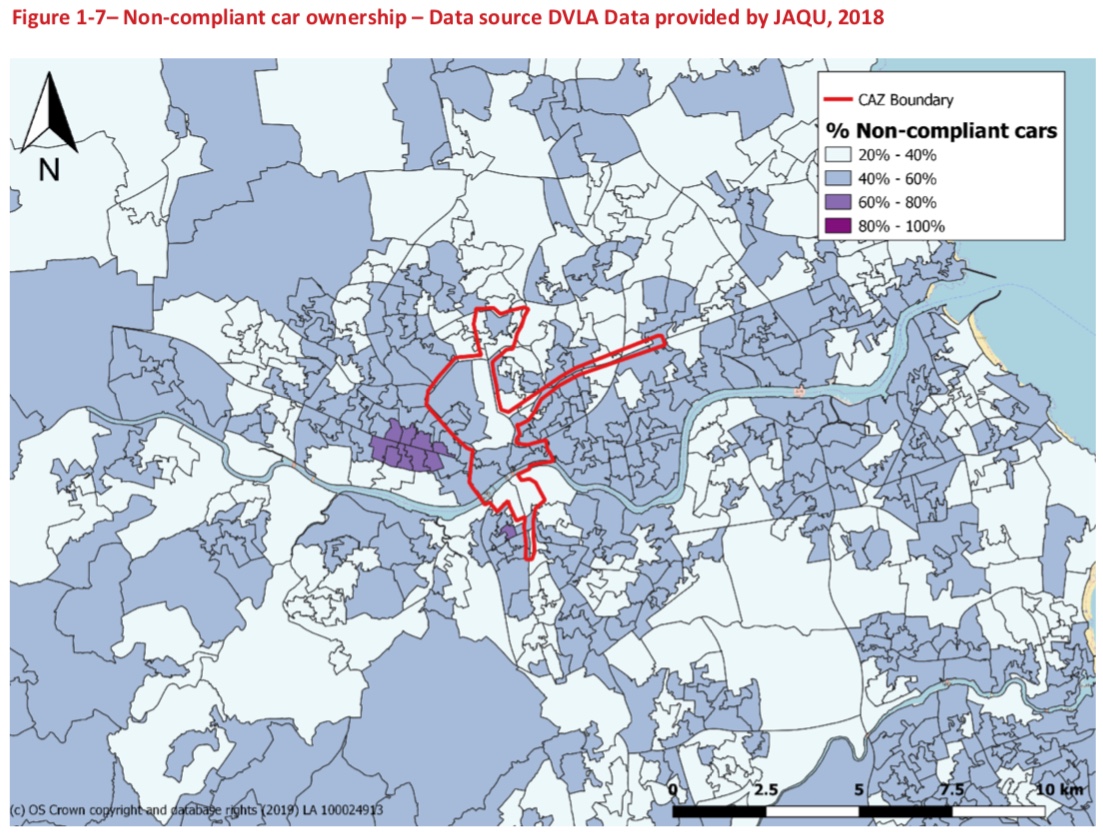
The analysis of the CAZ-D also showed that other areas surrounding the CAZ boundary might in some cases have increased air pollution as a result of the most polluting vehicles diverting to other routes. The map below gives some indication of this, although there is no suggestion that this will cause any of these areas to go over the legal limit.
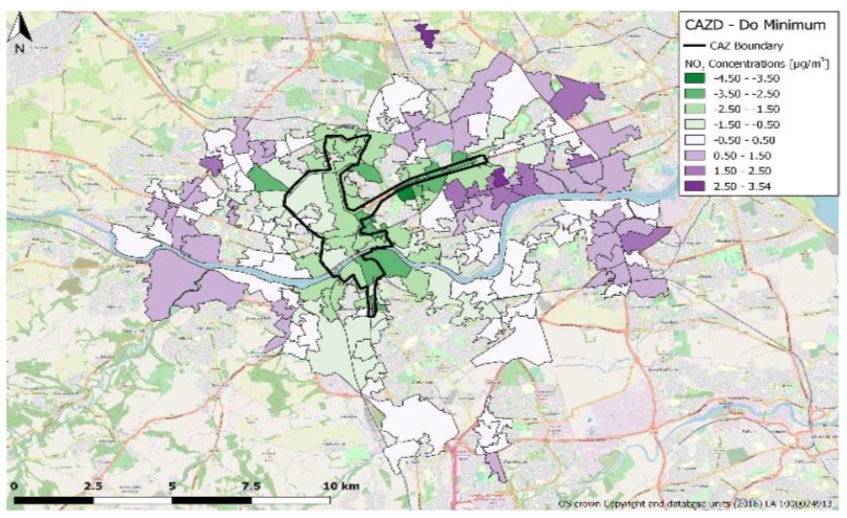
Air Quality if a CAZ-D is implemented vs the ‘Do Minimum’ scenario. Green = better; Purple – worse
For these reasons, the Council is proposing its alternative option.
Option 2: Tyne Crossing Tolls
The proposed tolls would only apply to Tyne Bridge, Swing Bridge and Redheugh Bridge, so there would be no charge for driving elsewhere in the city or in Gosforth.
While the effect on Gosforth or the Coast Road is therefore less certain, the are some potential advantages to the tolls:
- Even with the CAZ-D, and with the vast majority of traffic being compliant with emissions standards, the Central Motorway would still be over the limit in 2021. The Council estimates the CAZ will reduce non-compliant vehicles by 70%, but total traffic levels will only reduce by 9% as other compliant, but still polluting, vehicles will fill the space left. This means there needs to be some additional disincentive to reduce overall traffic levels in order to meet air quality limits.
- The charge for the toll could be a lot less than for a CAZ (£1.70 vs £12.50 for the CAZ according to the Chronicle). For comparison, a one-way Metro ticket from Monument to Gateshead would cost £1.50 per person vs £1.70 for up to 5 people in most cars.
- Buses could continue to use the High Level bridge with no charge, and other exemptions can also be agreed. The government’s CAZ approach requires that if non-compliant private cars are charged then buses, HGVs, LGVs and taxis must also be charged. If all buses are upgraded (as per the Council modelling assumption) then this would make less of a difference.
- Charges can be varied depending on the time of day e.g. to be higher during rush hour and cheaper when the roads would otherwise be quiet.
That said, we don’t know at this stage whether tolls will be effective in reducing pollution as the Council hasn’t yet completed its modelling of this option. The legal requirement is for a plan that is demonstrably likely to meet air quality targets. If the modelling does not support the required timescales then this option would automatically be ruled out unless it can be supplemented by other measures.
The most likely case is that it will be effective in the area close to the bridges, but less so further away. Clearly, for Gosforth this is a concern. There will be vehicles that travel down Gosforth High Street or via Haddricks Mill to the Tyne Bridge, and the toll might reduce the number of vehicles doing that. That effect would be limited though as there would be nothing stopping other, possibly more polluting, vehicles from taking their place.
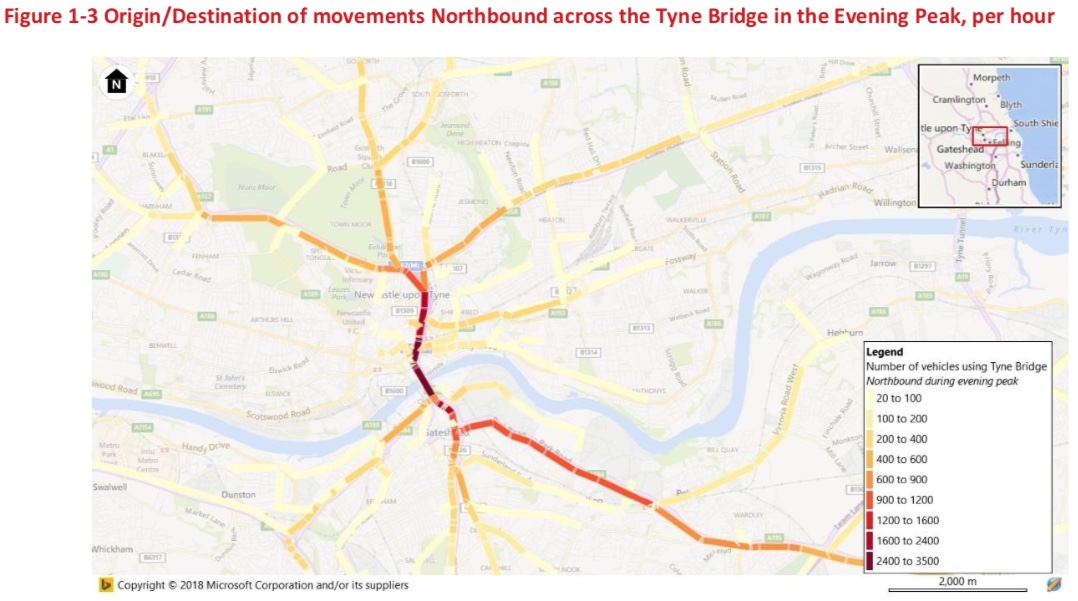
If the tolls aren’t sufficient then the Council would need to consider further options for Gosforth High Street and in other areas where limits are currently breached. One possibility might be a local Charging Clean Air Zone covering just Gosforth.
Another option to reduce pollution but without charging might be to restrict traffic flow along Gosforth High Street. SPACE for Gosforth’s analysis of Council data showed that the air was less polluted on Gosforth High Street during roadworks in 2016 when traffic was restricted, compared to the same period the following year when there was no restriction. The same analysis also showed that the temporary closure of Killingworth Road led to a substantial reduction in overall traffic levels.
Any revenue from the Charging CAZ or tolls has to be used by the Council for transport improvements, which could include further support to enable more people to use public transport, walking or cycling.
Other Measures
The Council have listed other measures they plan to consider for implementation in addition to either of the main options of a Charging CAZ or bridge tolls:
- A low emission zone covering Newcastle City Centre where non-compliant lorries, buses and taxis can only enter at certain times
- A ban on HGVs and LGVs using the Central Motorway in peak hours
- Junction changes on the Central Motorway to reduce queuing
- Walking and cycling infrastructure
- More moss walls or other local abatement
- Incentives for retrofit / scrappage of non-compliant cars, taxis, HGVs and LGVs
- Travel credits for people on lower incomes e.g. to use public transport
- A public campaign to encourage people to change how they travel and
- Exemptions for emergency service vehicles and blue badge holders.
No doubt it will be possible to suggest other measures in response to the consultation. In our recent blog Your Right to Clean Air, we set out some of our ideas that we hope will be considered. Whatever the chosen measures are though they will need to contribute to meeting air quality limits by 2021, ideally also contributing to the Council’s secondary objectives.
As above, the Council have already included an assumption that all buses will be upgraded to the latest EURO standard. This will be helpful for air quality on Gosforth High Street given there are 49 buses travelling in each direction every hour. In 2013 Newcastle University estimated that 28% of NO2 pollution on Gosforth High Street was generated by buses. Upgrading buses is therefore an important way to help meet air quality limits on Gosforth High Street but other measures would also be required.
Walking and Cycling
There is plenty of evidence available for what will be effective to encourage people to cycle or to walk more. For cycling this requires the creation of a network of routes that are safe and feel safe, avoid conflict with other road users, and provide direct access to the places people want to go. For children there is even research as to what type of route parents prefer and might be willing to use to get to school or on other journeys.
Studies have also shown that the benefits of cycling and walking ‘outweigh air pollution risk’ in cities even if cycling or walking on busy streets.
Improvements for walking, like reducing the wait times at crossings, can be implemented within a few weeks. Other cities have also shown that it is possible to implement good quality cycle networks very quickly. See for example Seville, Calgary and Macon in the USA.
The more choice people have for how to travel the easier it will be to meet air quality targets. Where people are made to be car-dependent, because there is no public transport, no safe cycle routes and local services are too far away to walk, then behaviour change initiatives will be far less effective.
Walking and cycling will also help meet all three of the Council’s secondary objectives. In our blog The Case for Healthy Streets we shared links to evidence for how walking and cycling can benefit health, support local retail and economic growth, extend the reach of public transport, and improve access to employment opportunities for the unemployed.
Consultation
The Council consultation will run from 6 March 2019 until 17 May. For further information see Newcastle City Council’s Air Quality webpage.
Following the consultation, the Council will produce its final plan, which must be submitted to government by 12 July 2019. In order for this plan to be approved by government, and considered for funding support, it will have to demonstrate that:
- It is likely to cause NO2 pollution levels to reach legal compliance within the shortest time possible (and provides a route to compliance which reduces exposure as quickly as possible);
- The effects and impacts on local residents and businesses have been assessed, including on disadvantaged groups, and there are no unintended consequences;
- Proposals that request UK government funding support demonstrate value for money; and
- The local measures have been carefully analysed using detailed local evidence and local air quality modelling tools.
As it stands the Council has not yet completed its modelling so we don’t know which of the two options will best meet the criteria for government approval and funding. If one achieves compliance quicker than the other then that is the option that must be chosen to reduce the risk to public health as quickly as possible.
Source Information
Newcastle City Council, Gateshead and North Tyneside were all directed by the government to complete and submit air quality plans in accordance with the government’s Air Quality Plan for Nitrogen Dioxide (NO2) in UK (2017).
Most of the information for this blog is sourced from the Council’s Tyneside Air Quality Feasibility Study. The final version of the Feasibility Study is available from the Cabinet Committee agenda (item 7).
This table, also from the Feasibility Study shows the percentage of vehicles that are non-compliant with CAZ standards nationally and locally.
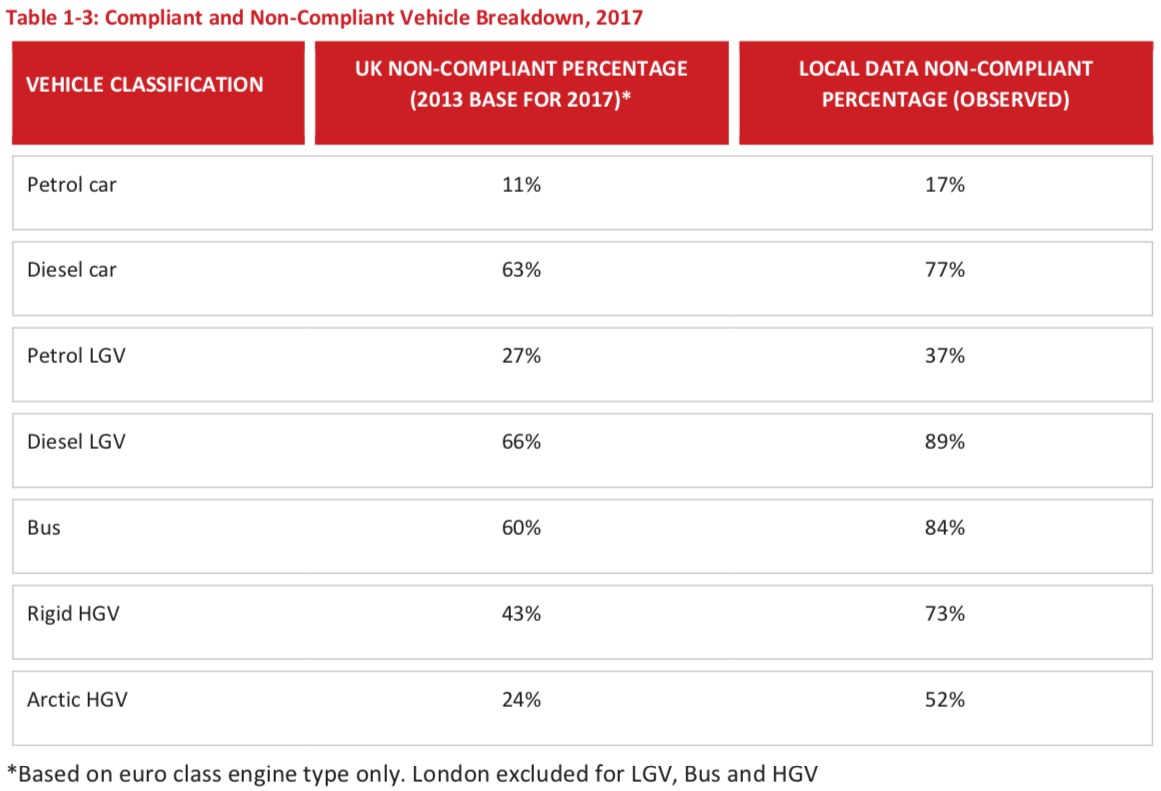

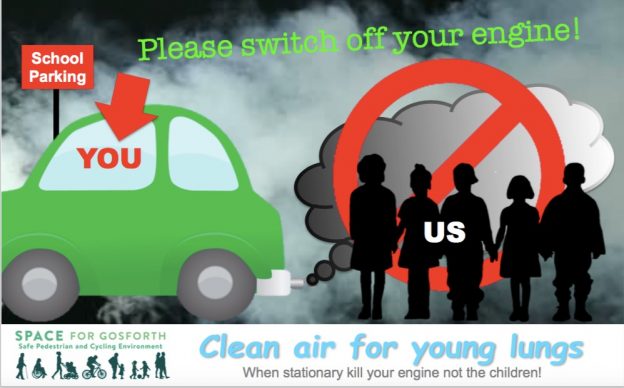
Re route all buses that don’t stop on the high street – all buses travelling into the city centre to terminate at the Region Centre Metro station and transfer passengers to the metro ( which is what many cities do )
The car is not going away so give us adequate parking facilities near Gosforth or the high street will die
I use the high street daily – I am not a cyclist I don’t use the inadequate public transport – but I don’t mind walking a short distance when I park my car
The only permanent solution is to pedestrianise Gosforth high street
Since deregulation in 1986, local authorities have no control over the routes taken by privately-operated bus services. As the post above also highlights, however, the buses on Gosforth High Street are only responsible for around 25% of the NO2 pollution here. The vast majority is from the 18,000 or so private cars and vans that travel along (and often through) the Great North Road each day.
One of the things that a toll or charges could do is act as both a carrot and a stick – the charge will encourage those who are able to travel to the High Street in other ways and it will also raise revenue that could be spent on improving that inadequate public transport to help people like you get to our local shops. Even if all the residential streets around the High Street were turned over to car parking, you’d still be looking at a few hundred spaces for people visiting our shops. Public transport, cycling, and walking have the potential to deliver thousands of customers to keep our High Street alive.
My flat faces Gosforth high street so I can not open my windows because even with double glazing the heavy traffic early in the morning disturbs my sleep. so my quality of life is lowered.The traffic doubled when they started the road works to at Killingworth and diverted the traffic via Gosforth high street.
Gosforth High street is where I do my shopping , it is also where I have to keep my eyes open for adults speeding on bikes on the pavement. I also have the delight of my lungs absorbing all the pollution. My concern for tolls is the wrong person would be targeted, for example a lot of goods for the region come via the big wagons over the bridges this may put up prices for the basic of life. It is the motorist who has no business in Gosforth but use it for a short cut because they are too lazy should be penalised.
Hi Mary, thanks for leaving a comment.
Lots to think about certainly, but it should be possible to reduce pollution and provide safe space for people to walk and for people to cycle if the Council is willing.
By any account one of the key “basics of life” is the air that we breath, so that should be a priority for all of us.
We haven’t done much on noise, but there are some scary health issues associated with that as well. We looked into that a bit here:https://www.spaceforgosforth.com/351-2/
Information about traffic volumes here also if you are interested. https://www.spaceforgosforth.com/roadworks-air-quality/
The overall plan seems a good initiative, however it appears to be flawed. The major flaw of the plan is that its not “aggressive” enough.
The first thing that needs to be reviewed is the charging of the CAZ-D, it shouldn’t be only that, in fact it could’ve been extended to make it so that it has a bigger reach, if it were to be done.
Another flaw is the overall idea of charging people for using their cars in certain spaces, while it is a good idea, it will have a lot of opposition, and there are many reasons for that such as those drivers are commuters that come to Newcastle to work.
Another thing that could be done is to build trees on a massive scale in places with no use.
Another good idea mentioned in the article is the use of public transport and making it affordable, but the problem is on the services, if the services are not good and have several delays that may push away people from using public transport.
Buses and maybe vans also need replacement in order to pollute less, a good idea would be creating electric buses and vans (it’s not as easy as it sounds, I’m aware of the council’s financial position) this would have to be done at a bigger scale, meaning that councils would have to work with the government as well as with businesses to come up with a way to renovate the buses and buses, e.g. subsidies, etc.
The same thing could be done with cars as electric cars are quite expensive for the average worker and there would need to be a significant drop in the prices.
Another idea would be creating an efficient network of trains or tram railway network, this could persuade people to use public transport if it is affordable for people.
For this to be done properly the council needs to work with the government in some aspects.
Reducing all forms of pollution is worthy and desirable, however the council and the green lobby should consider the unintended consequences, such as job losses, shrinking economy and declining productivity.
Public transport is simply not an option for a very large part of the population because it just does not serve peoples needs. The Metro system is very limited in it’s coverage and the services that are provided are not frequent enough and can not always be relied upon, buses are often dirty, crewed by rude unhelpful drivers, appear to run to no specific timetable and lurch and jerk along to the extent that for many older people they are considered to be dangerous to travel on.
The plight we face now has it’s roots in the catastrophic mistakes made by town planners in the 40s, 50s & 60s when residential areas were separated from commercial areas and new towns were lashed up without any thought on their impact and effect on existing infrastructure. Pre 2nd world war most people lived within walking distance of their workplace, shopped locally, employed local services and were educated in schools within walking distance of their abode, this of course has all changed, therefore the need to travel has become a necessity of life, so the great, good and worthy telling us we should travel less etc, have not thought things through.
Of course if everyone could get a nice well paid job in Newcastle Civic Centre and have a nice house in Gosforth near a Metro station all our problems would be solved !
Hi Philip,
Thanks for your comment.
We try to be led by the evidence so please say if you have found something different but what we have seen is that unconstrained car use isn’t a requirement for economic success and that cities that implement road charging don’t seem to suffer any adverse consequence of the type you describe. New York is currently considering road charging partly because too much traffic is creating a risk for its economy as well as the health of people who live there.
Broadly I think most people would agree that public transport could be improved. We would certainly support that and hope that the approaches being propsed by the Council can help achieve that. If you have feedback on the service or drivers, I’m sure the bus companies would like to know.
Certainly there have been, and continue to be, poor planning decisions that force people into car-dependency. There are also lots of short journeys currently being made by car where many don’t need to be. In Manchester their estimate is 250,000,000 journeys by car every year that are under 1km. That’s a ten minute walk for most people.
if the ULEZ ZONE is chosen, and I hope it isn’t, then I feel it only fair that those people living in the zone should be given a two year grace period in order to change their vehicle. It seems very unfair that those people who can afford newer, compliant vehicles, will not pay a penny under this scheme, while those that cannot afford to change their cars will be heavily penalised, especially if they live in the zone and will have to pay just to get their car off the drive. In London, people in the ULEZ will get quite a generous grace period to change cars, and if this scheme is adopted here, then the same concession should be applied to them. However, in the interests of fairness, then all motorists should contribute to cleaner air and this can be done with APNR tolls on the three bridges and the Tyne Tunnel